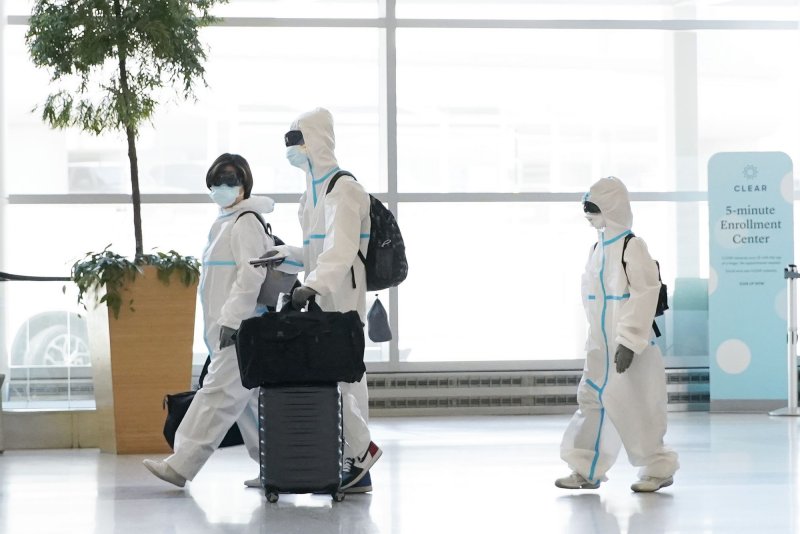1 of 5 | A man, woman and child walk through the San Francisco International Airport wearing full body plastic suits, face masks and goggles to protect against COVID-19 in August 2020. File Photo by John Angelillo/UPI |
License Photo
Aug. 16 (UPI) -- With COVID-19 infection rates rising in some places, while falling in others, and public health recommendations frequently changing, the pandemic has left many Americans confused about how to gauge risk.
According to a new survey, published Monday in the journal Decision, the public's perception of risk and mortality remains highly variable and often fails to correlate with the national infection rate.
"When the pandemic first began, things seemed scary in the abstract, and for many Americans, the worst of it was not in their own back yards," first author Stephen Broomell said in a press release.
"It's difficult to fully understand the risk of something that is not visible, and as many people failed to immediately experience the impacts of the pandemic, local experiences colored how serious they believed the problem was and even what kind of actions they were willing to take," said Broomell, an associate professor in the Department of Social and Decisional Sciences at Carnegie Mellon University.
Public perception of risk -- the dangers posed by tornadoes or climate change, for example -- is Broomell's specialty. His research aims to identify what it takes to get communities to take collective action to mitigate risk.
When the COVID-19 pandemic struck, Broomell and his colleague Patrick Bodilly Kane, a post-doctoral research fellow in the biomedical ethics unit at McGill University, developed a cognitive-ecological model to analyze how well different groups of people were perceiving risk.
Previous research has already found that misinformation spread quickly as many in the country relied on television and social media to learn about the coronavirus -- with everything from bots to those who question both vaccines and the pandemic overall to blame.
"There is not one pandemic debate but many pandemic debates," Kane said. "It is hard for people to connect their experience locally to a global phenomenon."
Broomell and Kane combined their model -- which followed a super-spreader progression and used local infection rates to anticipate an individual's perception of risk -- with survey responses collected at the outset of the pandemic to better understand how local perceptions of risk track with national infection rates.
"It's not that people were wholly unaware of the national and international infection rates, but because of the way this particular disease spread within clusters, there was a real chance that an individual might not have encountered anyone who they knew to be infected," Broomell said.
"Every community had an equal probability of experiencing a cluster, but for any given community, especially at the beginning, this probability was low," Broomell said.
Early in the pandemic, researchers found people were not accounting for super-spreading events as the primary driver of infection.
They also were relying on information about the pandemic from national institutions and media. Local organizations were limited in their ability to gauge and communicate risk.
Their research also showed that local infection rates had the biggest impact on how people perceived pandemic risk and national infection rates.
If local infection rates were rising, people were more likely to take a graver view of rising national infection rates. However, if infection rates remained low, people were less likely to take an ominous view of rising national infection rates.
"Understanding this interplay between what people see and how disease really spreads will help us as we prepare for similar situations in the future," Broomell said.
The study authors suggest the insights provided by their research are applicable to other types of crisis, including the climate.
"The thing that is creating the disaster is affecting all of us, but at different times," Kane said. "This dynamic is present in a lot of places where you might not expect it. People cannot see larger trends because they are caught up with what is in front of them."
Previous studies have shown that local experiences can influence perceptions of climate change. For example, in places that have experienced rising sea levels and severe flooding, people are more likely to support actions to mitigate climate change.
"We've known for a long time that people have been personally experiencing climate change in widely divergent ways, which, much like with COVID-19, impacts their sense of urgency to take action," Broomell said.
"While psychological reactions to global climate change will take decades to fully understand, the pandemic played out much more quickly, showing the world how difficult it can be to get people to agree on risks that ultimately affect everyone," Broomell said.















